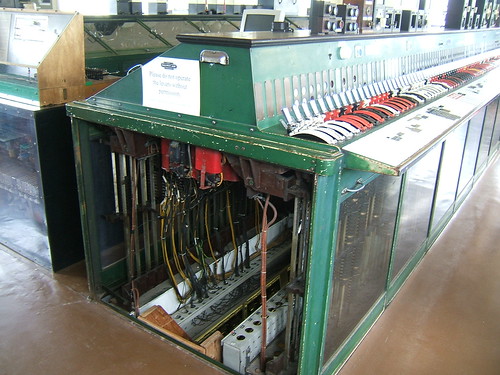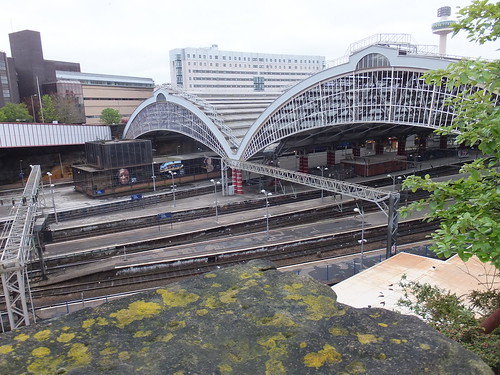 Lime Street: the Train Sheds viewed from the car park off Lord Nelson Street.
Lime Street: the Train Sheds viewed from the car park off Lord Nelson Street.
The railways around Liverpool have always had a fascination for me, particularly because of Liverpool's position at one end of the Liverpool and Manchester Railway which was the "first main line passenger railway in the world".
Then and Now
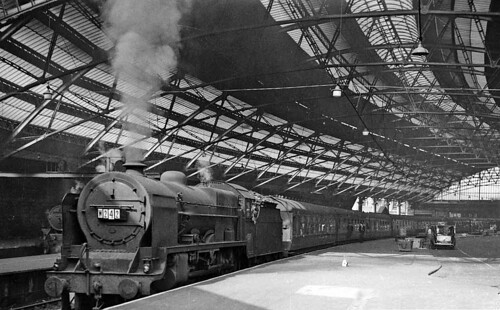 Click for larger image.
Click for larger image.
Liverpool Lime Street on 13th June 1959. View looking westward towards the buffers, with LMS Fowler 6P 4-6-0 No. 45515 'Caernarvon' ready to leave on the 10.05 express to Bournemouth West, which will run via Crewe, Birmingham New St., Bath and the Somerset & Dorset line (Photo: Ben Brooksbank via Wikimedia Commons [CC-BY-SA-2.0]).
 Liverpool Lime Street on 19th May 2012. View westward towards the buffers on Platform 8 with 4-car EMU 350 115 (almost hidden) ready to leave for Birmingham New St.
Liverpool Lime Street on 19th May 2012. View westward towards the buffers on Platform 8 with 4-car EMU 350 115 (almost hidden) ready to leave for Birmingham New St.
Brief History
The Liverpool and Manchester Railway opened in 1830 but the original passenger terminus at Liverpool was not at Lime Street but at Crown Street, Edge Hill. First Class passengers were provided with a horse-drawn carriage service between Crown Street and Dale Street, near the commercial centre of the city. From Edge Hill, there was also an inclined tunnel just over 2 km long cut through sandstone, shale and clay to Park Lane Depot near Wapping Dock. Locomotives were initially prohibited from this tunnel so passenger and goods trains descended to Park Lane by gravity, controlled by Brakemen on the train and trains were hauled back up to Edge Hill by rope, using stationary steam winding engines.
The success of the railway meant that these arrangements proved inadequate and a further Act authorised a new tunnel from Edge Hill to Lime Street Station. This tunnel was just over 2 km long, principally through sandstone, and inclined at a gradient of around 1 in 93. Further winding engines were provided at Edge Hill (together with a new station) and the approach to Lime Street was rope worked from 1837 until 1879. The first station buildings at Lime Street (completed in 1836) were designed by John Foster Junior and had a 2-storey classical facade.
In 1845 the Liverpool and Manchester Railway was absorbed by the Grand Junction Railway which, the following year,became part of the London and North Western Railway.
In 1849, the original Lime Street Station was replaced by a design by Sir William Tite extending along Lord Nelson Street. This included an iron segmental-arched train shed by Richard Turner, following his success in creating the Palm House at Kew.
The present train sheds were built in two stages. The north shed by William Baker has a span of 200 feet - the largest in the world at the time it was built. It was completed in 1867, together with the North Western Hotel in French Renaissance style by Alfred Waterhouse which is now accommodation for university students.
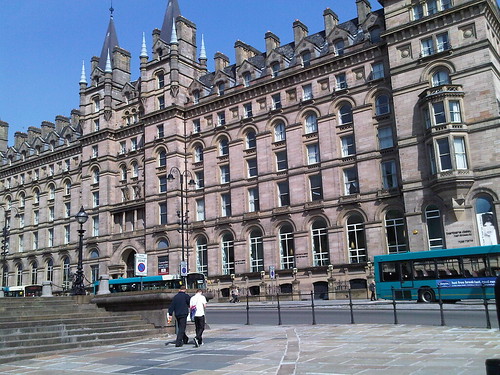 Alfred Waterhouse's French renaissance frontage masks William Baker's north train shed.
Alfred Waterhouse's French renaissance frontage masks William Baker's north train shed.
The south train shed (by Francis Stevenson and E. W. Ives) followed in 1879.
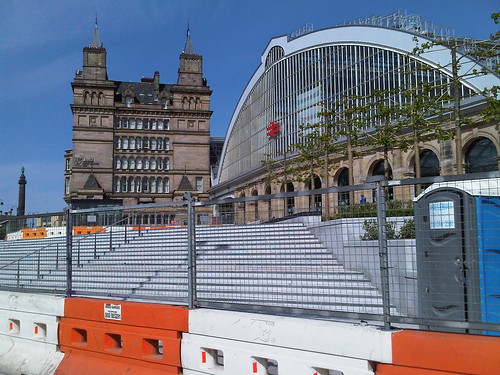 View of the road frontage of the south train shed.
View of the road frontage of the south train shed.
The Railway Act of 1921 grouped the railways into the 'Big Four' (L.M.S., G.W.R., L.N.E.R. and S.R.) and Lime Street became part of the L.M.S. Upon Nationalisation in 1948, the London Midland Region of British Railways took over many of the L.M.S. assets.
The Approach to Lime Street
After 1879, locomotives started to haul trains in and out of Lime Street Station. Conditions passing through a busy 1-mile long tunnel were hardly ideal and, in 1882, the tunnels were 'opened-out' leaving a deep cutting with various short tunnels and a myriad of criss-crossing bridges carrying streets. For trains leaving Lime Street, with a 'green' fire and an engine not yet 'warmed through', the gradient of 1 in 93 for about a mile up to Edge Hill was something of a challenge to enginemen throughout the steam era,
Gradient diagram Weaver Junction - Liverpool Lime Street, showing (right) the approach to Lime Street on a 1 in 93 incline.
 Lime Street: Looking towards Edge Hill from Platform 7 with a DMU approaching the local platforms on the north side of the station.
Lime Street: Looking towards Edge Hill from Platform 7 with a DMU approaching the local platforms on the north side of the station.
Signalling
 The 'A.R.P.' style signal box at Liverpool Lime Street in May 2012. The route is set for a departure from Platform 9 to the Up Fast.
The 'A.R.P.' style signal box at Liverpool Lime Street in May 2012. The route is set for a departure from Platform 9 to the Up Fast.
The Westinghouse Style 'L' 'All Electric' power frames introduced electrical interlocking between miniature levers as a development of the earlier Style 'K' which had miniature levers but mechanical interlocking. The London, Midland and Scottish Railway installed a number of the Style 'L' frames, including the one at Liverpool Lime Street. In 1940, an order was placed for a 95-lever frame for the new 'ARP' style signal box at Lime Street with 31 point levers, 58 signal levers and 6 spare levers.
For more information about the Style 'L' frame, refer to Book Reference [1] 'The Style L Power Frame'. For more information about Liverpool Lime Street signal box, click here. This page is part of the splendid site 'Westinghouse Brake and Saxby Signal Co. Ltd miniature power lever frames'.
External Links
Liverpool Lime Street railway station (Wikipedia).
Liverpool Lime Street (Network Rail).
Liverpool and Manchester Railway (Wikipedia).
London and North Western Railway (Wikipedia).
London, Midland and Scottish Railway (Wikipedia).
Map References
You can find a detailed signal box diagram for Liverpool Lime Street in the excellent series of publications from the Signalling Record Society publication 'British Railways Layout Plans of the 1950's'. Liverpool Lime Street is in 'Volume 9: LNW Lines Crewe to Euxton Junction, Liverpool to Manchester (and associated branches)' (ISBN: 1 873228 11 2).
For details of the layout in 2005, refer to 'Railway Track Diagrams Book 4: Midlands & North West', Second Edition, published by Trackmaps (ISBN: 0-9549866-0-1).
Book References
[1] 'The Style L Power Frame' written and published by J. D. Francis 1989 (ISBN 0 9514636 0 8).
[2] 'Liverpool & Manchester Railway 1830-1980' by Frank Ferneyhough published by Book Club Associates.
[3] 'A Regional History of the Railways of Great Britain': Volume 10 The North West by G. O. Holt, Second Edition published by David & Charles (ISBN 0946537 34 8).
My Pictures
Liverpool: The City.
Liverpool Area Railways.

